Day 3 of a three day Late Autumn / Early Winter Tour, our last day. It was a grey and misty start, but brightened up mid morning with the sun even showing itself for a while. Then the cloud returned for the afternoon, and the mist rolled back in later too and there were a few spots of rain for a short time. We still had a great day out, exploring NW Norfolk.
To start the day, we headed over to the Wash. It wasn’t one of the biggest tides of the month today, but it should still be big enough to bring a lot of the waders within range so we could see them. As we made our way in at Snettisham, our first Goldeneye and a couple of Tufted Ducks were diving in the pit below the crossbank.
The tide was already in, but there was still lots of mud in the far corner. The sky was full of birds, a huge flock of Golden Plover wheeling round in their thousands, before dropping back down. We headed down towards Shore Hide and stopped to scan the mud. A black stain out in the mist was a large slick of roosting Oystercatchers and there were thousands of of Knot spread across the mud behind, although they were hard to see clearly given the poor visibility.
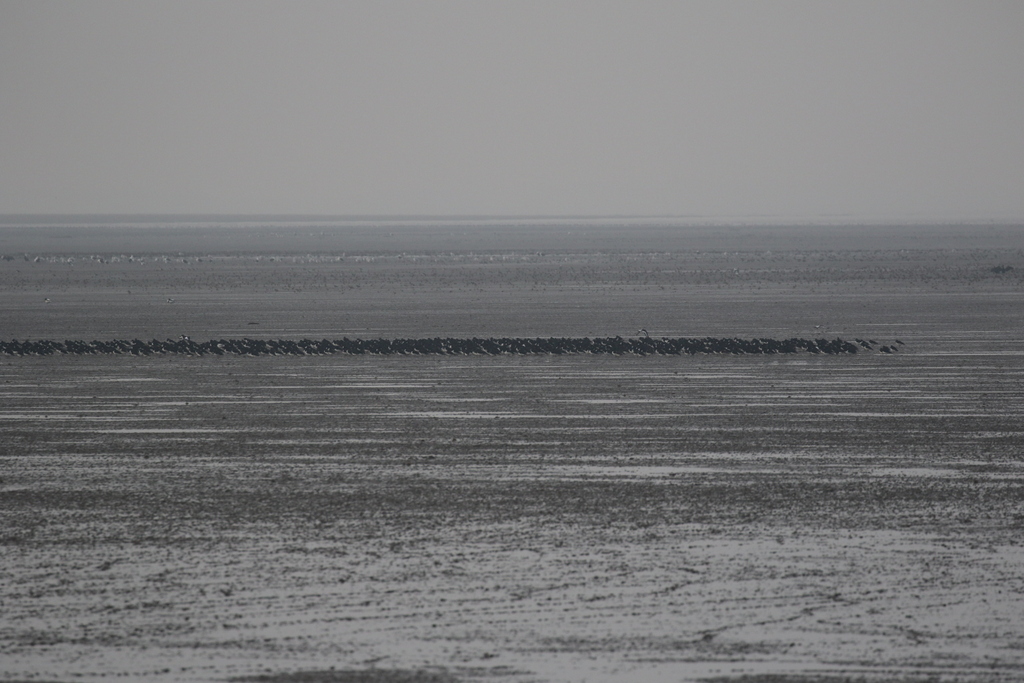
There were some waders closer in, which were easier to see. A single Avocet walking around in the shallow water was the first for the weekend. There were Grey Plovers and Dunlin liberally scattered round the mud and a good number of Ringed Plovers too. Several Bar-tailed Godwits were feeding further back, on the shoreline beyond the mud, but one came closer in to one of the pools just beyond the channel, where we could get a better look at it. There were one or two Curlew roosting in the middle, but many more over towards the vegetation away to our left.
The mist started to lift, and the sun broke through behind us. The Golden Plover were shining in the light, and the line of Knot now looked more bright white than dull grey.
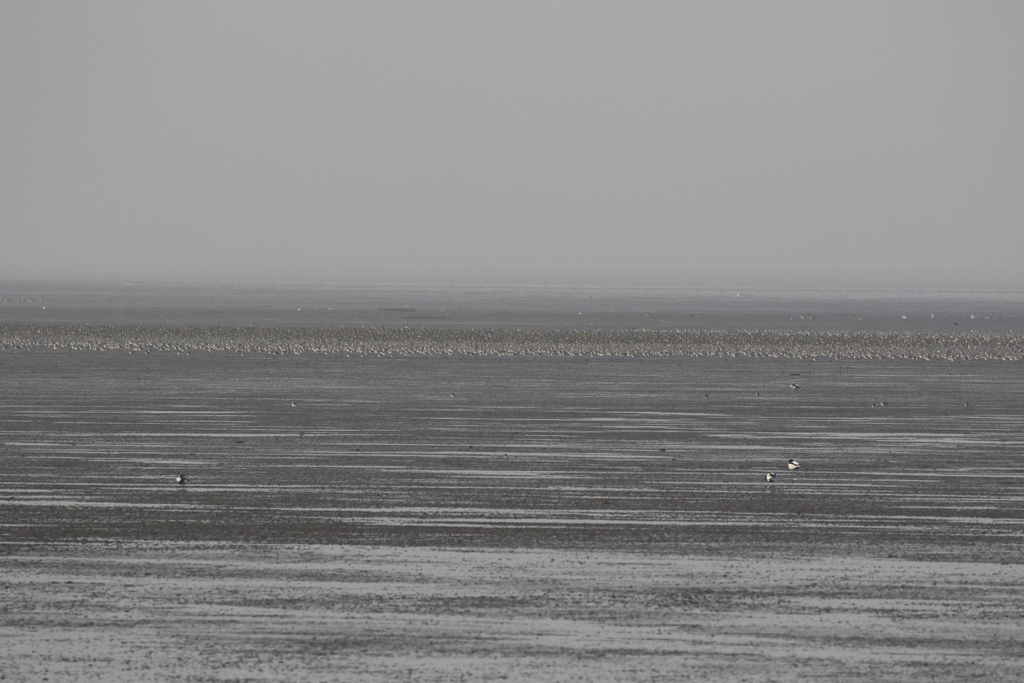
A little group of Wigeon down around the muddy pools just below the bank looked stunning in the sunshine. There were lots of Shelduck out on the water and a few Pintail in amongst them, along with Teal and Mallard. Six Pink-footed Geese were still out on the mud where they had roosted, with one or two flying in and out over our heads.
As we turned round to walk further along, six swans flew past just beyond the pits. They were Whooper Swans, heading south presumably down to the Fens where they will spend the winter.
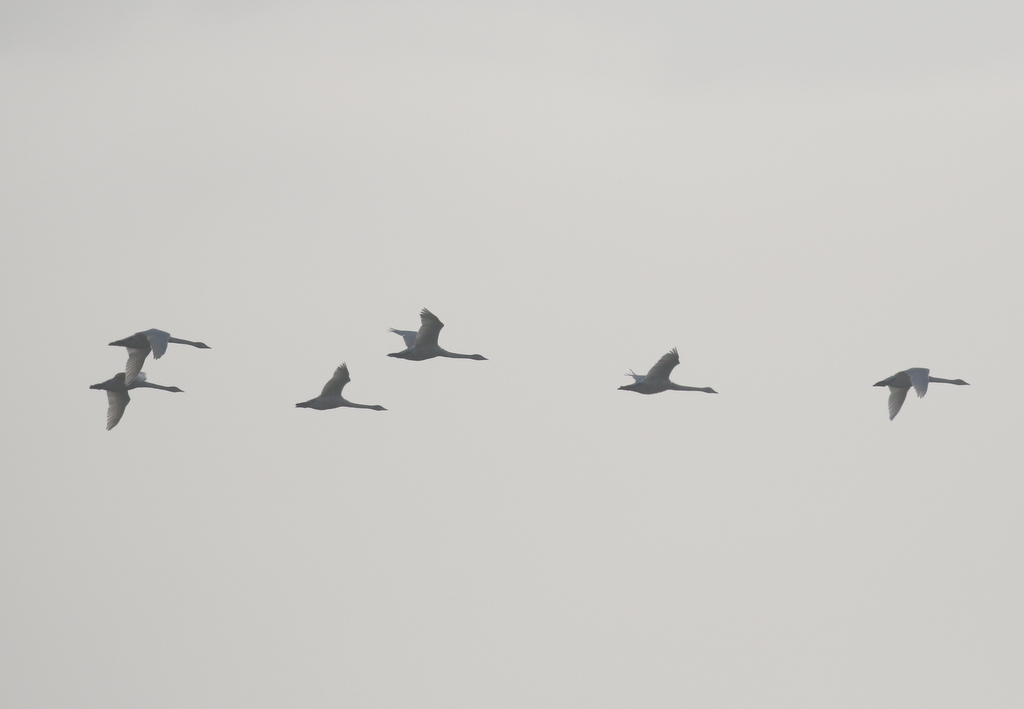
A juvenile Gannet flying in over the mud towards us was a bit of a surprise. It was presumably disoriented by the mist, and seemed to realise its mistake as it headed back out to the Wash. Down opposite Shore Hide, a Common Seal had hauled itself out on the dry mud on the side of the channel. It looked more like a log until it raised its head and looked over at us.
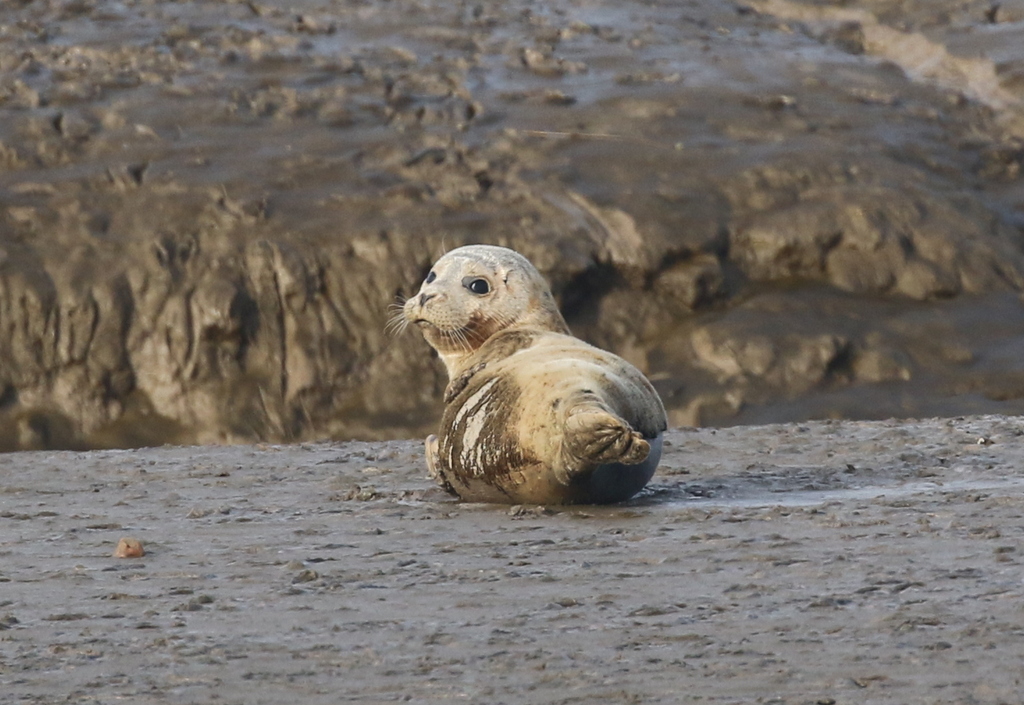
As we got into the hide and opened the windows, two Kingfishers shot past over the water in front of us, calling. We saw a flash of electric blue as they flew past.
Scanning the water, one of the first ducks we picked up was a Scaup on its own out in the middle. It was asleep at first but quickly woke up and headed over to the gravel bank at the back where it started diving repeatedly. There was a small group of Tufted Duck further over to the left, including one female with some white round the base of its bill, not as extensive as the Scaup. There were several Goldeneye scattered around the pit too – white males and darker females.
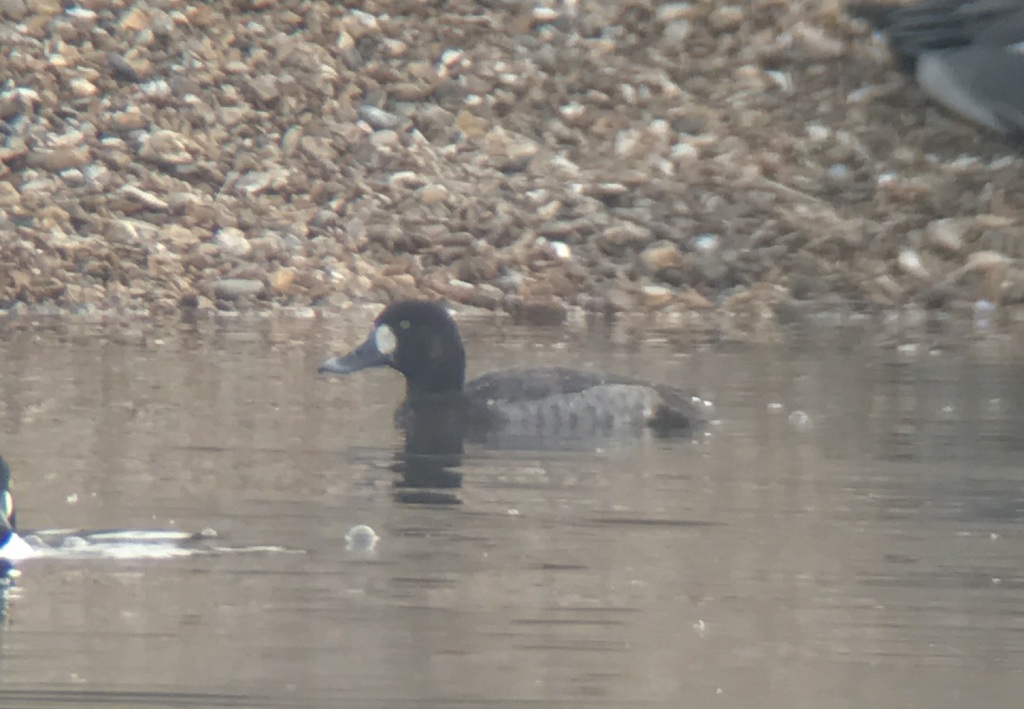
There were lots of dabbling ducks on here too – mainly Wigeon, a few Gadwall and several Mallards including some feral domesticated ones. There were a few Little Grebes and one Great Crested Grebe as well.
Continuing round, we looked across the water to see a Kingfisher perched in an elder bush on the bank across the other side. We stopped to get the scope onto it, face onto us, showing off its bright orange underparts. Then we spotted a Short-eared Owl nearby, roosting out in the open on the edge of some brambles. Quickly turning the scope onto this, we had a good look at it. Mostly asleep, we could see its short ‘ear’ tufts on the top of its head.
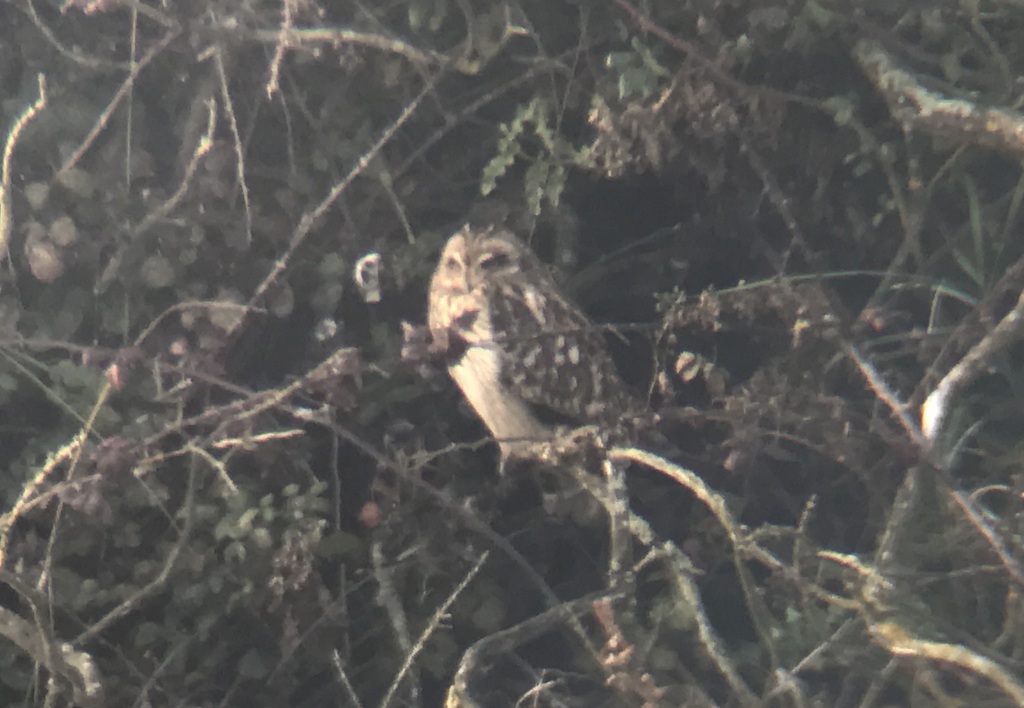
As we walked back to the minibus, the mist started to descend again. We made our way back round to the north coast and stopped at Thornham Harbour. There were lots of people out for a Sunday walk along the seawall, and more down on the road, walking out along the jetties to the boats and round the old coal barn, looking into harbour channel.
Needless to say, it was too disturbed for many waders to be lingering here. There was a Curlew in the channel but it flew off as we walked past, and otherwise just a few Common Redshank. There were a couple of Rock Pipits in the channel behind the old barn.
We walked round to the seawall. There were lots of Linnets, but they were all up in the lone tree out on grazing marsh. A couple of Reed Buntings were with them briefly too. The Linnets flew off in a couple of flocks, but headed straight out into the middle of the saltmarsh. Presumably where it was quieter.
Clearly it was not going to be very productive here today, so we headed round to Titchwell for lunch. There was not much coming in to the feeders by the Visitor Centre, just a couple of Chaffinches and a few Goldfinches, plus one or two tits. After lunch, we headed straight out onto the main path.
A small group of people were staring up into the trees up by the Meadow Trail junction. When we got up to them, we could see lots of Goldfinches feeding in the alders. There were a few Siskin and at least three Mealy Redpoll in with them too, but they were hard to see, constantly moving. With a bit of persistence, we eventually managed to get the scope on some for long enough for everyone to see them. A Treecreeper appeared in the trees too – an uncommon bird here.
As we got out of the trees, it was grey and misty again now. There was nothing of note on the reedbed pool, so we continued straight out to the Freshmarsh. As we scanned from the main path, we could see lots of Avocets still. Most have headed off south already, but almost 50 are still lingering for the time being. The surprise of the day was seeing a pair mating. The female stood with her head and neck held down, horizontal, while the male walked round and picked at the water or preened, before mating. It is a common enough sight in the spring and summer, but this was the wrong time of year for that!
There were plenty of Golden Plover on the islands, although nothing to compare with the number we had seen at Snettisham ealrier, and a good number of Lapwing. A single Black-tailed Godwit was standing in the shallow water in the middle, our first of the trip. A little group of Dunlin was feeding busily on the mud just below the bank. A flock of Knot flew in and whirled round over the Freshmarsh but didn’t land.
There were plenty of ducks too – lots of Teal and Wigeon, a few Gadwall and Shelduck. We heard a Water Pipit calling a couple of times, and eventually found one picking around on the short vegetation on one of the islands. We had a good view through the scope – white below with neat black streaks, grey-brown above with a well-marked pale supercilium.
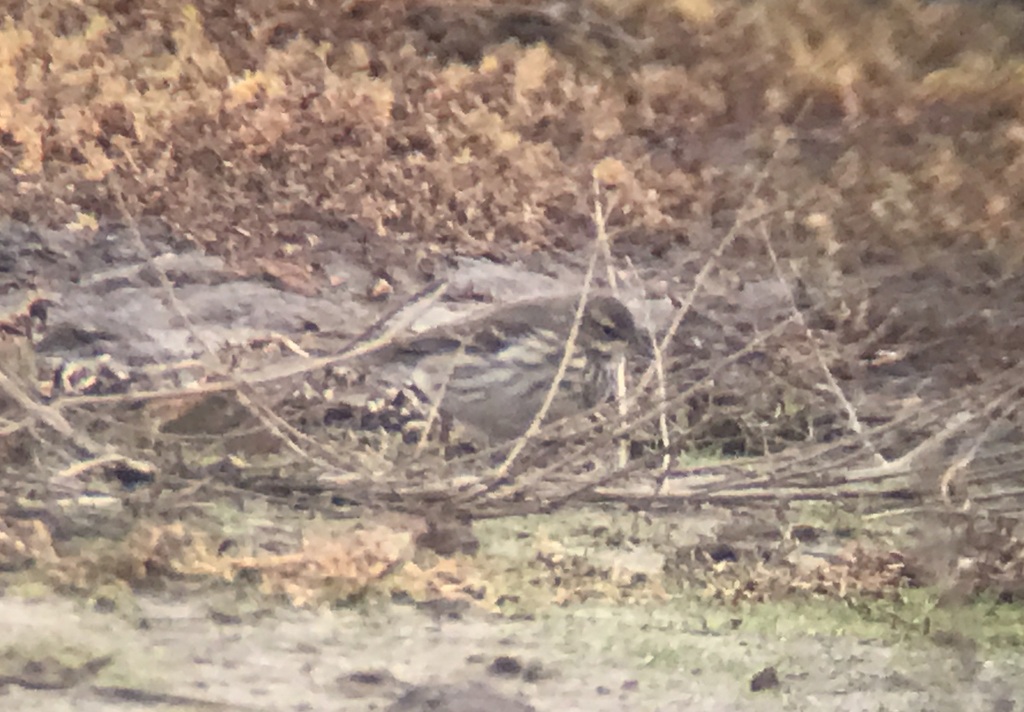
The sky was getting greyer, and it looked like the weather might close in, so we headed straight on, out towards the beach. We stopped to scan the channel at the far end of Volunteer Marsh, where there were several Redshanks, a couple of Curlew and a single Grey Plover. A small group of Knot appeared out of the vegetation on the edge of the mud beside the channel. It was good to get a closer view after seeing so many but at distance earlier.
It started to spit with rain as we walked over the bank to the Tidal Pools. We quickly picked up a Spotted Redshank, feeding with its head and bill down under the water, walking round quickly and sweeping its bill vigorously from side to side. As one point, it was in the same view as a Common Redshank, and as well as the very different feeding action, the Spotted Redshank was noticeably paler too, with a longer, finer bill. There was also another Black-tailed Godwit here and several Grey Plover at the back.
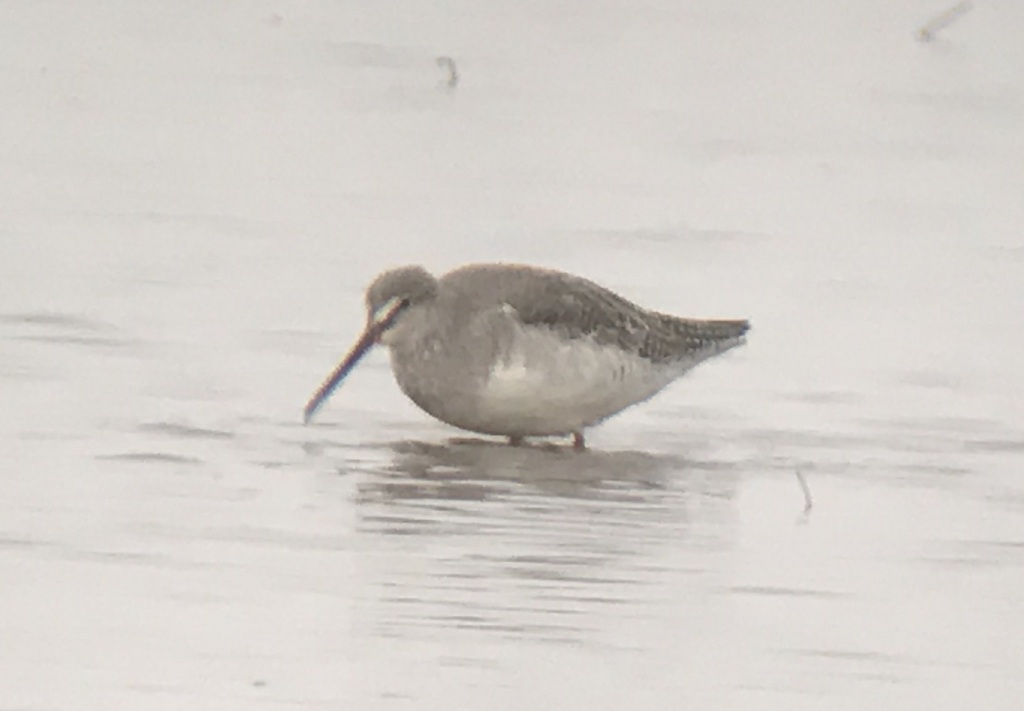
The rain stopped, so we made a quick bid for the beach. The tide was out and it was unfortunately too misty to see any more than a short distance offshore – we could just make out a few Great Crested Grebes and a small group of Red-breasted Mergansers. We could see thicker cloud approaching from the west, so we didn’t linger and turned and headed for Parrinder Hide as the rain picked up again.
There were lots of gulls already gathering on the Freshmarsh. An adult Yellow-legged Gull was in with them, rather mid-grey-backed and with only limited light streaking on its white head, as well as yellow legs. There were a few Lesser Black-backed Gulls and a single Great Black-backed Gull nearby, and one or two adult Herring Gulls to allow us to compare. Several shades of grey!

There was a Water Pipit on the island straight out from the hide, but when it flew we lost it. Then someone pointed out one on the island to the right of us. When the first reappeared from amongst the Golden Plover, we realised we had two. Pied Wagtails started to drop in on the islands, gathering pre-roost – we counted at least 15. We realised there were now three Water Pipits present.
The light was going fast now, but at least the rain had stopped, so we decided to head back. It was still rather misty, but we could see five or six Marsh Harriers circling out over the reedbed, getting ready to go to roost. It was time for us to head in to roost too!
It had been a great three days, with a fantastic selection of birds – lots of newly arrived winter visitors, as well as a couple of late rarities too.
















